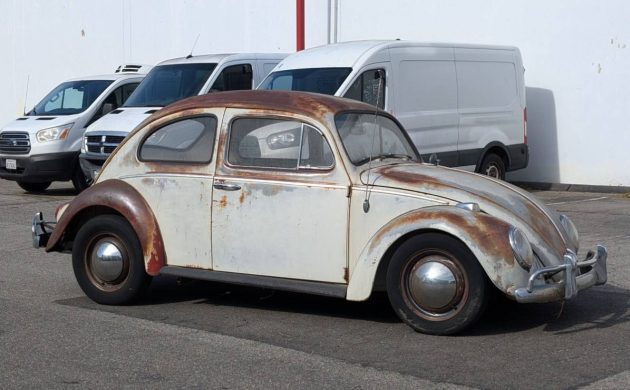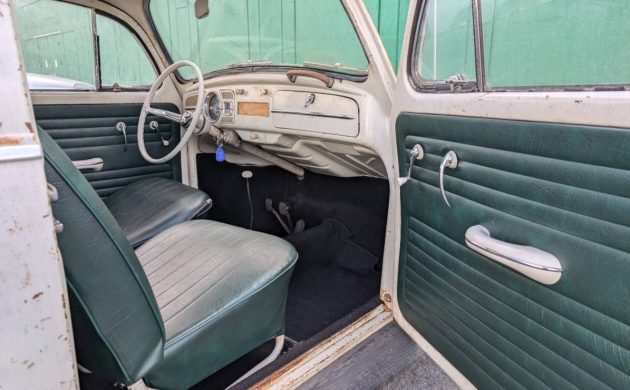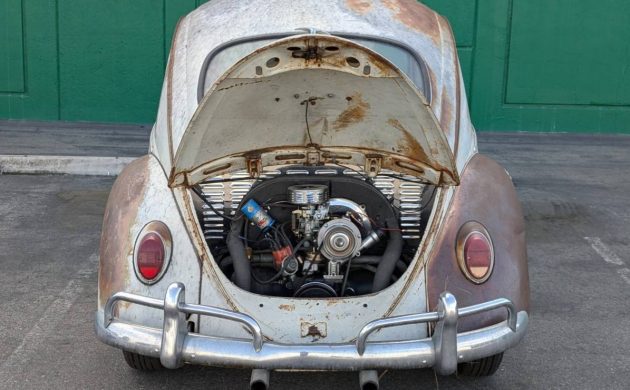One of the more curious things to me about vintage cars is when you see them pop up in the most unlikely of places. This 1963 Volkswagen Beetle is offered for sale by a company that appears to specialize in lightly-used fleet/commercial vans, the kind that you likely see local Amazon drivers using in your community. This Bug is displaying some impressive patina, and appears to have a few modifications as well. How do you think this Beetle ended up at this van lot? Find it here on craigslist for $11,995.
Thanks to Barn Finds reader Chuck Foster for the find. Right off the bat, you notice that the front ride height has been dropped down. Perhaps it has a spindle kit, and if it does, the builder clearly prefers the “raked” stance as the rear end appears to sit higher than the front. These earlier Bugs that sport the slimmer turn signal lenses with classic chrome bumpers and overriders are among my favorites, and with the standard rear window (not an oval or split), you’ll pay less of a premium for these preferred cosmetic features. The Bug also appears to be fairly solid, but there’s no information about the pan.
White with green is an interesting color combination, and I have to believe the interior color is somewhat rare. Brown/tan, navy, white – all of these colors seem far more common. This Beetle reflects a smart approach to improving/modifying a vintage car: the high costs associated with a paint job and having perfect cosmetics are avoided by living with the authentic patina, which is almost as desirable as a pristine finish. There is some surface rust in the door sills, and it doesn’t appear to have penetrated the metalwork. The interior doesn’t need to be redone either, although you could certainly find a detail shop willing to clean up the vinyl buckets.
A 1963 Beetle had about 40 horsepower in standard form and 63 lb-ft of torque. I suspect this engine is not stock, with the first clue being that panel behind the compartment between the engine and the backseat. What it appears to be is a louvered firewall offered by the likes of Empi. It appears to be a purely cosmetic upgrade, and it does offer some eyeball appeal under the engine lid. The fact that this Beetle is for sale by a van seller likely means it belongs to someone at the business in the background, so hopefully, you can find someone on the lot with a personal connection to this patina’d VW.





As the days and weeks drift by, it’s becoming more and more evident, I will never own a Bug. You can lower the front by adjusting the torsion bars front suspension, that alters ride and control, but must look cool and that looks like a 40hp. The generator( now an alternator) stand is the key. The panel was strictly a measure for additional cooling. We never needed that in the North Pole. The ad says Nashville, but the company is out of California, and that’s where this Bug came from. Bugs simply don’t exist much anywhere else. Far as Bugs go, the ’63 had a slew of improvements carried over from the ’62, like a gas gauge. Cool find, $12gs for a Bug, yep, it’s California all right.
A note for you Howard, lowering the front end does not change the ride or control but does do wonders for aerodynamics. That’s important if you put one of the 150 hp engines in back giving you a 120 mph top speed. You got me wondering just how many Bugs are in California as it seems they are everywhere out there. Picture shows our present build with the nose down attitude for aerodynamic purposes as the Bugeyes need all the help in that line as we can get.
Hi bobhess ( Bob?), sorry, I have to disagree. I was a VW mechanic for a short time, the guy told me he was strictly against it. Like the old Plymouth “torture” bars, I had a Valiant I messed with them and it never handled the same. Lowering a VW affects steering response, increased tire wear, and changes the stock geometry of the suspension.
You do have to realign the front, the tow-in particular as the lowering changes the angle of the tie rods, which is where the tow is adjusted. If you want to put a slight negative camber in it shims on the axle/torsion bars works for that. On pure race cars we heated those ends and bent them slightly to get about 2 degrees of negative camber. Can do that to change the castor too. If the angle of the tie rods bothers you, you can flip them over to the opposite side of the control arms or heat and bend the arms where you need them.
Bob, there are plenty of early-bugs around, but aren’t common, just like any particular car from that era. The best way to find something like that is go into an area that hasn’t had a lot of turnover. Even in the parts of the Bay Area where a typical 3 bedroom 1,200sp/ft house sells for nearly $2,000,000 you will see a large number of houses with older cars and trucks parked in the driveways. Those are the houses someone bought prior to the mid-1990’s, when there were still manufacturing jobs, before high tech became dominant. Those people don’t move unless they are chasing their kids or grandchildren who are now priced out of the market.
The best way to find cars is figure out those where those neighborhoods are, drive around and do the knock and talk.
Steve R
Agree on all that Steve. We bought our “one of everything” house in ’92 for $83,000. It’s value now is $800,000. What we are seeing now is a big boom of used cars and trucks. Average house painter isn’t going to buy a 60K truck.
This reply is actually for Howard. I’ve had a 67 Bug 42 years. When I got it it was stock and sat high in the front end. A common problem on older 67 Bugs. I could actually feel the front end getting light in a strong head wind. At first I put a bag of concrete in the trunk and that helped. As soon as I could afford it I bought and installed off set spindles to lower the front end. I didn’t do any of the other things that some people do to get them really low. With this method there is no restriction in front end suspension travel and I’ve had no problems with alignment or uneven tire wear. It also handles better. They’ve been on my car for 40 years and 170,000 miles.
Thanks for mentioning the addition of the fuel gauge in ’63, Howard. I was just trying to remember if my first (drivable) VW was a ’62 or a ’63. It had a gauge, so clearly it was a ’63. Thanks for making that so easy! I marvel that it was only 7 years old when I bought it at age 15 in 1970 with my paper route money. My cars right NOW are 22-25 years old. And happily so. (Toyotas, don’t cha know?)
My father had a 58 VW, brought back from Europe by another USAF member. As it had no gas gauge, when it started to sputter, it was time to flip the lever under the dash with your foot to connect the reserve tank. If I was riding in the car when this happened, I always was given the job of reaching down there (as a kid, my legs weren’t long enough) and turning it. We had a lot of good times in that car until my brother rolled it at 25 mph. Then it became a dune buggy.
Price is steep for all that patina. Hard to say what engine is in there but it’s still a single port but the car has been converted to 12 volt with a single wire alternator. Nice to see it’s still running a SVDA distributor and Solex. Ditch the air cleaner and install the correct one with engine preheat. Ditch the fuel filter as well. California car probably has good sills and pan and definitely should be painted at some point.
IMO the fuel filter is a wise mod but it definitely should be metal, not the plastic version. Classic VW’s are famous for engine compartment fires and plastic fuel filters are often the culprit.
And put some hose clamps on it. If I remember right the cause of the many engine fires in the classis VWs was because there was no hose clamp on the fuel line at the carburetor.
There’s correct and not correct way to lower vehicles…
Should we assume that someone found that the Beetle wasn’t the ideal vehicle for their parcel delivery business and traded it for a Sprinter van?
I grew up in the era when you could buy nice pre 1968 Beetles for under $200. I owned a slew of them. Yeah, I know times have changed but ain’t nol way I’d pay $12grand for a rusted 1963. Call me jaded.
Agree Russell.
$11,995 + dealer fees for a bug that needs the front suspension fixed and a paint job I will keep shopping.
I was a VW mechanic for a short time, the guy told me he was strictly against it. Like the old Plymouth “torture” bars, I had a Valiant I messed with them and it never handled the same. Lowering a VW affects steering response, increased tire wear, and changes the stock geometry of the suspension.
You do have to realign the front, the tow-in particular as the lowering changes the angle of the tie rods, which is where the tow is adjusted. If you want to put a slight negative camber in it shims on the axle/torsion bars works for that. On pure race cars we heated those ends and bent them slightly to get about 2 degrees of negative camber. Can do that to change the castor too. If the angle of the tie rods bothers you, you can flip them over to the opposite side of the control arms or heat and bend the arms where you need them.
Interesting discussion. I put a modest 2.5 inch lift in my CJ7. Steering and tracking suffered.
Daily driver + no A/C is a tough sell for me in my old age. In the 1970’s I went through 3 of them and loved every one. Brother crashed 1, I crashed the next, 3rd broke down too far away to fix it and got towed and abandoned. I loved those cars. Closest thing to it I ever had was a 1987(?) Mitsubishi sedan that was equally simple and repairable, 1500cc, roll up windows, heater no A/C, fm radio two speakers, lasted 250K. But it never had the same feeling in the drivers seat as those old bugs.
Cut and turn the front torsion tubes ..
Put the front end back to the stock ride hight when it came from the factory. That solves the camber and everything. Beetles are not race cars. So all the lowering and changing things is not needed. All the rust needs to be removed or new panels and repainted in the original color. The rust is still eating away at the metel under the clear coat no matter what anybody says or thinks.
I know they sold billions but there is absolutely nothing to recommend these abominations. No acceleration. No cruising speed. No brakes. No handling. Not roomy. No stowage. No heat. No A/C. Quirky notions like a windshield washer “pump” run off your spare tire, heralded as “German engineering.” Sure they are easy to fix and they run forever. Same as my Briggs & Stratton lawn mower. And I know I’ve had more fun with it.
Glad you enjoyed your lawn mower, bub, but many of us also enjoyed our beetles – with all of their quirks.
Dude inhaled too much LA smoke. 11K !! More like 5 grand tops. I’ve owned 2 of these over the years, and I enjoyed the hell outta them. Not worth this amount.
From the lights and lid it’s a 64.
Check the VIN against the Idiot Book 1st edition.
Claiming a 63, could have built for year model 64, from August of 63.
The Select a Drop front end, does you no favors, especially at highway speeds.
Looks like it is in Costa Mesa, OC, Cali. Where everyone is stuck in traffic.